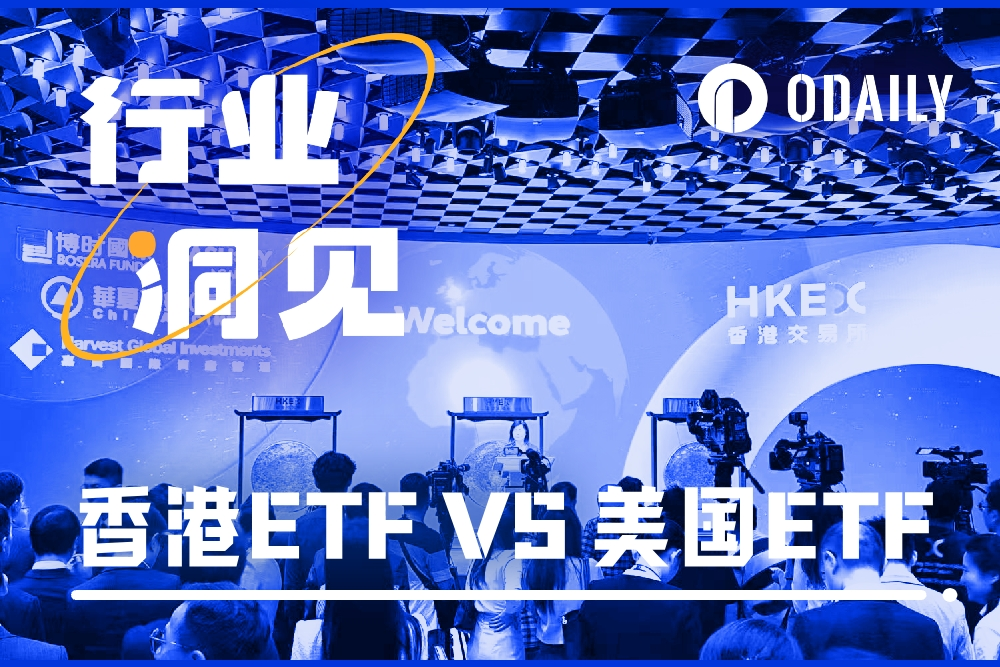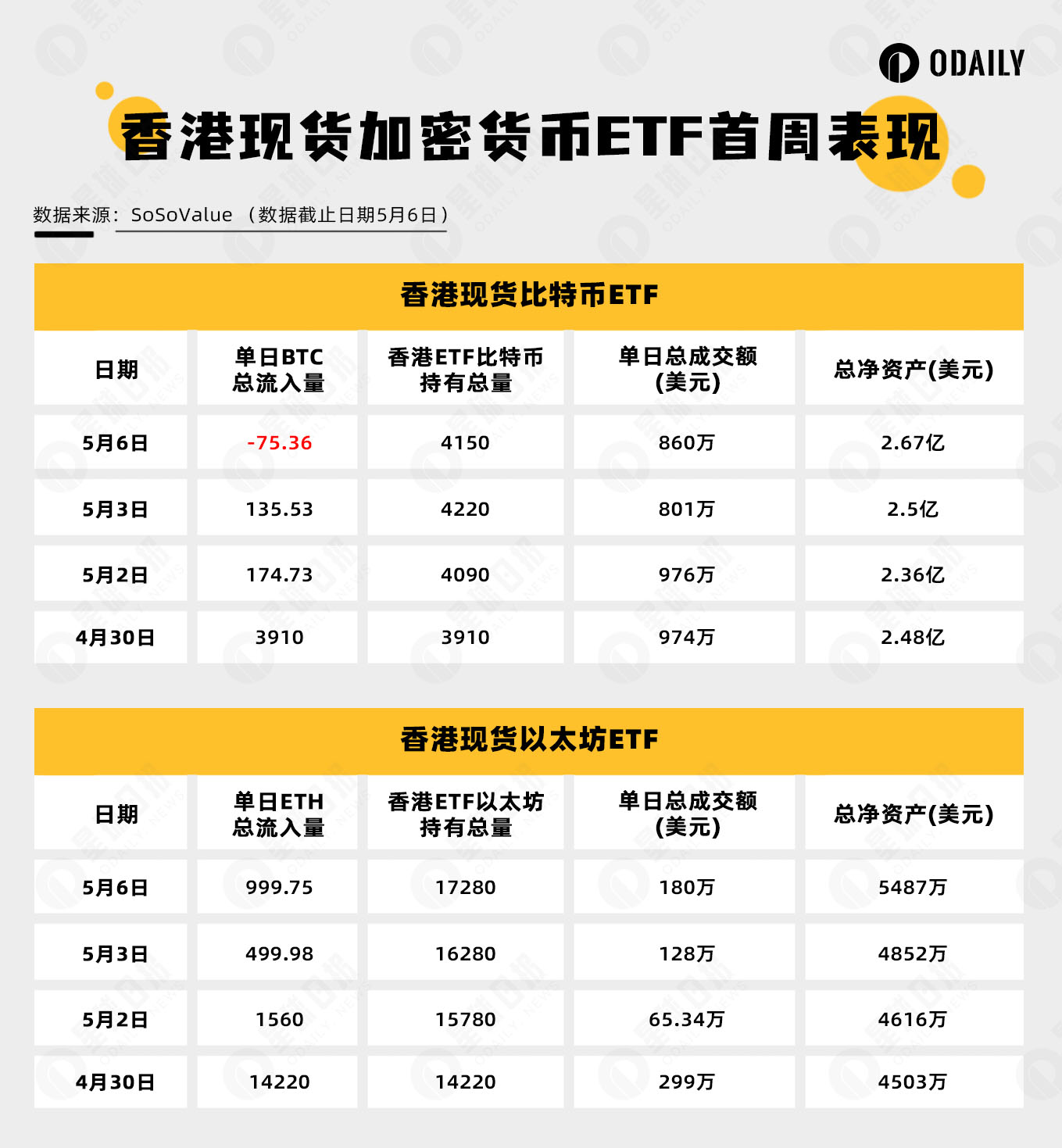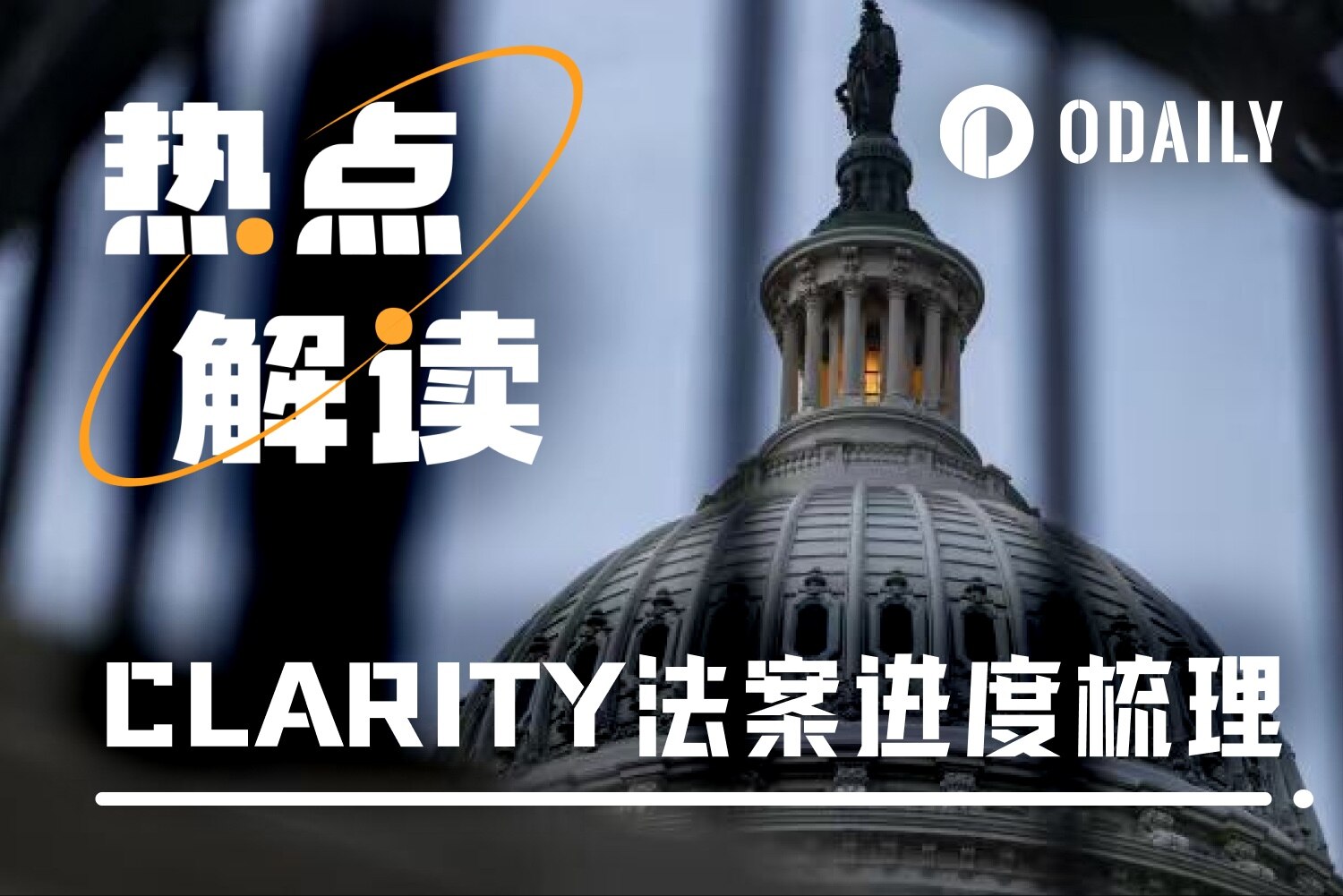One week after the launch of the Hong Kong crypto spot ETF, why did two local asset managers buy the US version of the ETF?
Original | Odaily Planet Daily
Author | How to

On April 30, the much-anticipated Hong Kong spot cryptocurrency ETF was officially listed on the Hong Kong Stock Exchange. This was also the first time that an Ethereum spot ETF was listed on a major exchange. Currently, Hong Kong spot cryptocurrency ETFs are mainly issued by China Asset Management (Hong Kong), Bosera Funds (International) and Harvest International, including Bosera HashKey Bitcoin ETF (03008), Bosera HashKey Ethereum ETF (03009), China Asset Management Bitcoin ETF (03042), China Asset Management Ethereum ETF (03046), Harvest Bitcoin Spot ETF (03439) and Harvest Ethereum Spot ETF (03179).
From April 30 to May 6, the Hong Kong spot cryptocurrency ETF has just been online for a week. How has it performed? How is the Hong Kong spot cryptocurrency ETF different from the US spot Bitcoin ETF issued earlier this year? Does it have unique competitiveness to attract capital inflows from Asia Pacific and even the world?
To this end, Odaily Planet Daily will review the development of Hong Kong spot cryptocurrency ETF in one week and make a comprehensive comparison with the US spot Bitcoin ETF.
Although the performance on the first day was not satisfactory, there is still hope for the future
In terms of nominal time, the Hong Kong ETF has been open for a week, but in terms of actual open trading days, excluding the May Day holiday and weekends, the total number of open trading days for Hong Kong ETFs is 4 days. During these four days, the Hong Kong spot cryptocurrency ETF raised about HK$2 billion on the first day, and the net asset value was calculated to be US$293 million, which is an advantage compared to the US spot Bitcoin ETF's net asset value of US$113 million on the first day.
But with the end of the first day of trading, according to SoSoValue data , the total trading volume of the first six crypto asset spot ETFs issued in Hong Kong was about HK$87.58 million (about US$12.7 million), far lower than the US spot Bitcoin ETF's first-day trading volume of US$4.66 billion.
Why is the actual trading volume on the first day so different when the Hong Kong spot cryptocurrency ETF has a fundraising scale more than twice that of the US spot Bitcoin ETF?
There is a big gap in the market size between the two. Compared with the global financial center of the United States, Hong Kong's radiating range is relatively small, especially it is not open to ordinary mainland investors for the time being, resulting in a lower actual transaction volume.
The level of acceptance of cryptocurrencies is low, and traditional financial practitioners (and institutions) in Hong Kong and even Asia still have a certain gap in their understanding of cryptocurrencies compared to Europe and the United States.
The high scale of fund-raising in Hong Kong is attributed to its unique “physical subscription and redemption” mechanism, which enables many ETF investors to purchase ETFs in the form of Bitcoin and Ethereum during the new subscription period, resulting in a higher amount of funds raised.
In the three trading days that followed, the performance of Hong Kong's spot Bitcoin ETF and Ethereum ETF was relatively average, as shown in the figure below.

As can be seen from the figure, in the first three days, the transaction volume and capital inflow of the six ETFs in Hong Kong were relatively stable and positive. However, on May 6, the Bitcoin spot ETF experienced its first net outflow (75.36 BTC), valued at approximately US$4.75 million.
Although Hong Kong's spot cryptocurrency ETF fell short of expectations in terms of scale and trading volume, many celebrities remain optimistic about the future of Hong Kong ETFs.
Eric Balchunas, senior ETF analyst at Bloomberg, had previously predicted that it would take two years for the Hong Kong virtual asset ETF market to reach the $1 billion level, but it hit $292 million on the first day, which means that the view of the Hong Kong virtual asset ETF market needs to be readjusted. He also said that although the trading volume is not as good as that of the United States, in terms of proportion, the $310 million Hong Kong ETF is equivalent to the $50 billion in the US market. Therefore, the impact of Hong Kong virtual asset ETFs on its local market is as great as that of the US spot Bitcoin ETF on its local market.
HashKey Group COO and HashKey Exchange CEO Weng Xiaoqi said that the scale of HashKey Exchange's custodial assets has increased from 2.2 billion yuan before the ETF was released to 3.3 billion yuan, and he believes that a large amount of funds will continue to flow into the market in the future. At the same time, Weng Xiaoqi believes that ETFs can attract more traditional investors to enter the virtual asset market, and the overall scale can reach 20% of the US market in one year, that is, about 10 billion US dollars. He believes that the virtual asset market is still a long way from saturation.
Sui Chung, CEO of CF Benchmarks, a subsidiary of crypto exchange Kraken, expects Hong Kong Bitcoin ETF assets under management to reach $1 billion by the end of 2024.
In addition to the positive views expressed by celebrities on the future of Hong Kong spot crypto asset ETFs, Tiger Brokers (Hong Kong) has also officially launched virtual asset trading services, becoming one of the first technology brokers in Hong Kong to support the trading and management of traditional securities and virtual assets on one platform. However, Tiger's virtual asset trading services are currently only available to professional investors. In the future, subject to regulatory requirements, Tiger Brokers plans to extend virtual asset trading services to retail investors. In addition, the company will also consider adding virtual asset spot deposit and withdrawal services.
US Spot Bitcoin ETF “VS” Hong Kong Spot Crypto Asset ETF
Not long after the Hong Kong spot crypto ETF was officially launched, on May 3, according to Watcher.guru, two Hong Kong asset management companies have purchased up to US$112 million in US spot Bitcoin ETFs. Data showed that in addition to Yong Rong Asset Management's purchase of BlackRock IBIT ETF worth US$38 million, another Ovata Capital Management purchased four US spot Bitcoin ETFs with a total investment of more than US$74 million.
Why did Yong Rong and Ovata choose to buy US spot Bitcoin ETFs instead of going far away?
According to the original text disclosed by Watcher.guru, the relevant data came from before the official issuance of the Hong Kong spot crypto ETF, and the two companies did not adjust the timing of their moves based on the progress of the Hong Kong ETF.
Assuming that we start from the perspective of these two asset management companies, most asset management companies buy assets for their future development prospects, and most likely hold them for a long time, and long-term holding requires considering related expenses. However, judging from the basic information disclosed by the three Hong Kong issuers, Huaxia 1.99%, Harvest 1.00% and Bosera 0.85% are higher than the 0.25% fee of US spot Bitcoin ETFs. Although the three issuers have reduced the fee rate to encourage investment transactions, from a long-term perspective, the high fee setting will inevitably be a "stumbling block" for many long-term investors.
Secondly, from the perspective of market size and trading volume, the Hong Kong spot crypto ETF has just been launched, and the market size is smaller than the US spot Bitcoin ETF, which has been developed for nearly 4 months. Larger markets often bring better liquidity and trading experience.
Finally, from the perspective of fund custodians, the custodian of the US spot Bitcoin ETF is Coinbase, while the custodians of the Hong Kong ETF are HashKey Capital and OSL Asset Management. Judging from the scale of custody and past trust foundation, Coinbase is obviously superior.
Does Hong Kong spot ETF have no advantages? Not necessarily. The current significant differences between the two are in three points:
Hong Kong pioneered the "physical subscription mechanism" : Compared with the US spot Bitcoin ETF, which can only be traded in cash, the physical subscription mechanism can provide investors with a more flexible trading method and increase trading enthusiasm. In addition, the physical subscription mechanism has a great role in promoting Web 3. The physical subscription mechanism can serve as a capital exit channel for Web 3 investors, open up the links between traditional finance and Web3, and facilitate the circulation rate of capital in the later stage.
Regional coverage : After all, the trading time of the US spot Bitcoin ETF has a certain time difference and policy barriers with Asian countries, which is not conducive to Asian companies to carry out corresponding work. However, the launch of the Hong Kong spot crypto ETF will prompt Asian related companies to purchase Hong Kong spot ETFs under the condition of better physical conditions.
The first Ethereum spot ETF : The most special advantage is that Hong Kong is ahead of the United States in launching the first Ethereum spot ETF. Assuming that the US SEC does not approve the application for the spot Ethereum ETF this month, then at least this year, Hong Kong will be the only region that supports the spot Ethereum ETF. This will help attract the participation of Ethereum-related investors and seize the opportunity.
The channel has been opened, looking forward to potential expectations
In fact, on the day when the Hong Kong spot crypto ETF was launched, the community had more negative views than positive ones due to the market falling due to the failure to meet expectations and the outflow of the US Bitcoin spot ETF. However, after a few days of development, the Hong Kong spot crypto ETF still has a certain role in promoting the crypto market.
From the aforementioned first-of-its-kind subscription mechanism to open up the funding channel between traditional finance and Web3, to the trading scope radiating to Asia, all of these reflect Hong Kong's support for the development of Web3. Secondly, compared with Western countries, it will take some time for Hong Kong and even Asia to accept cryptocurrencies. Finally, the potential expectation left by Hong Kong's spot crypto ETF is to open up the trading channel in the Mainland.
As Kaiko's latest report shows, the competition for cryptocurrency spot ETFs is heating up around the world. In fact, Hong Kong is not competitive in terms of products compared to the United States, and ETFs are not meant to create a confrontational situation. The most important thing is that the issuance of ETFs can strengthen the liquidity of existing Web3 funds and flow traditional funds to Web3. On the contrary, when the market is sluggish, ETFs also provide a high-quality channel for the "escape" of Web3 funds.



